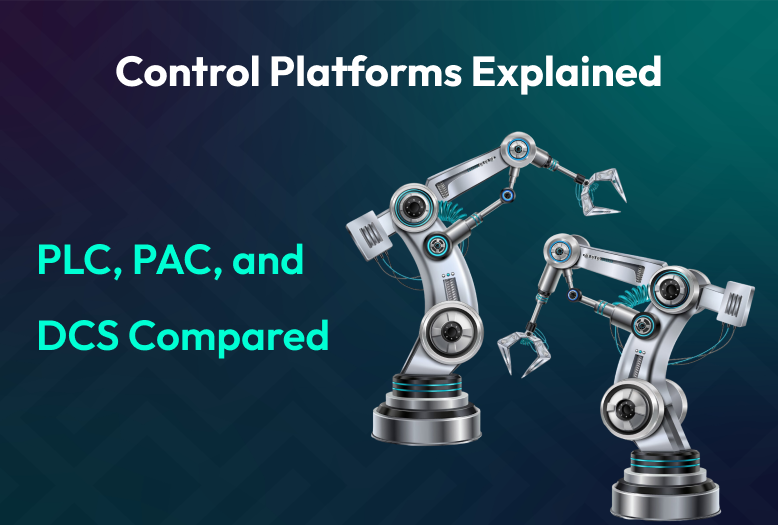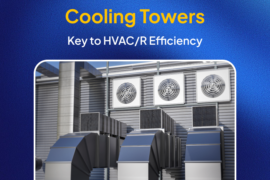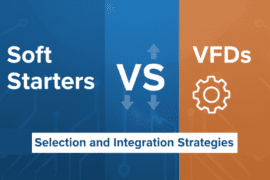PLC, PAC, and DCS each play a vital role in industrial control systems, but the lines between them can sometimes blur especially as technologies evolve. This blog offers a clear, structured breakdown of how these systems differ, where they overlap, and how each fits into modern automation and HVAC&R environments.
The reality is that each control platform fits best in specific scenarios, and understanding these differences is going to help decide how to design and manufacture control systems. Whether you’re working on a simple rooftop unit controller or a complex district cooling system, the control platform you choose will impact everything from initial costs to long-term maintainability and system performance.
This guide will break down the key differences between PLCs, PACs, and DCS systems with real-world examples. No vendor bias, no unnecessary jargon, just clear, actionable insights to help you make the best choice for your specific application.
What you’ll learn:
- Clear definitions and capabilities of each control platform
- Real-world HVAC&R application examples for PLCs, PACs, and DCS
- Practical selection criteria to guide your decision-making
- Key documentation considerations for successful implementation
The Control System Crossroads – Making the Right Choice
1. Understanding Each PLC, PAC, DCS Control Platform: The Good, The Great, and The Comprehensive
PLC: The Reliable Workhorse
Programmable Logic Controllers (PLCs) are the backbone of industrial automation. Think of them as the reliable workhorses that excel at discrete control tasks. These rugged devices evolved from relay-based systems and continue to dominate applications where straightforward, dependable control is paramount.
PLCs shine in applications with clear on/off logic, sequential operations, and moderate I/O requirements. They’re built for reliability, with scan times measured in milliseconds and the ability to operate in harsh industrial environments for years without issues.
Where PLCs Excel in HVAC&R:
- Rooftop Unit Control: Managing dampers, fans, and heating coils based on temperature setpoints and occupancy schedules
- Pump Control Systems: Sequencing multiple pumps in chilled water or heating water systems with basic lead/lag logic
- Simple Air Handling Units: Controlling smaller AHUs with straightforward temperature and humidity control requirements
- Industrial Exhaust Systems: Managing exhaust fans, dampers, and basic interlocks for safety and efficiency
Real-World Example: A 20,000 square foot office building uses PLC-based controllers for three rooftop units. Each PLC manages fan operation, economizer dampers, heating and cooling stages, and basic alarms. The system needs to be reliable, cost-effective, and maintainable by local technicians. This is exactly where PLCs deliver.
PAC: The Versatile Performer
Programmable Automation Controllers (PACs) represent the evolution of control technology, combining PLC reliability with PC-like flexibility and power. They’re a strong choice when your system needs to handle multiple types of control, complex logic, or lots of device communication.
PACs come with faster processors, smarter programming options, and easier integration with business systems. They’re built to manage complex logic, detailed diagnostics, and modern user interfaces; all in one system.
Where PACs Excel in HVAC&R:
- Central Plant Systems: Managing multiple chillers, boilers, cooling towers, and pumps with advanced sequencing and optimization
- Complex Air Handling Units: Controlling large AHUs with variable frequency drives, multiple control loops, and integration with building management systems
- Industrial Process HVAC: Managing environmental systems in manufacturing facilities where precise control affects product quality
- Energy Management Systems: Implementing sophisticated energy optimization strategies across multiple HVAC systems
Real-World Example: A pharmaceutical manufacturing facility uses PAC-based control for its cleanroom HVAC systems. The PAC manages precise temperature and humidity control, coordinates multiple air handling units, handles complex pressure relationships between rooms, integrates with the facility’s energy management system, and provides detailed data logging for regulatory compliance.
DCS: The Process Control Champion
Distributed Control Systems (DCS) are engineered for large scale, process driven environments where continuous processes, extensive data management, and high availability are essential. These systems distribute control functions across multiple controllers, reducing single points of failure while giving operators a clear picture of the entire process.
DCS platforms excel at continuous process control, advanced regulatory strategies, and managing thousands of I/O points across geographically distributed locations. They’re designed for applications where downtime isn’t just costly, it’s potentially catastrophic.
Where DCS Excels in HVAC&R:
- District Energy Systems: Managing campus wide heating and cooling distribution with multiple generation sources
- Large Industrial Facilities: Controlling HVAC systems in power plants, refineries, or chemical facilities where environmental control is critical to the process
- Complex Central Plants: Managing utility systems (steam, chilled water, compressed air) across entire industrial sites
- Mission-Critical Environments: Hospitals, data centers, or research facilities where HVAC system reliability is paramount
Real-World Example: A university campus uses a DCS to manage its district cooling system serving 40 buildings. The system coordinates multiple chillers, manages complex distribution networks, optimizes energy usage across varying loads, provides comprehensive operator interfaces, and maintains detailed historical data for energy analysis and optimization.
2. Quick Reference: PLC, PAC, DCS Platform Comparison
| Platform | Best For | System Scale | Programming | Integration | Typical Cost |
|---|---|---|---|---|---|
| PLC | Discrete control, simple logic | Small to medium | Ladder logic, function blocks | Basic networking | Low |
| PAC | Multi-domain control, complex algorithms | Medium to large | Multiple languages, object-oriented | Advanced networking | Medium |
| DCS | Process control, high availability | Large, distributed | Function blocks, sequential control | Enterprise integration | High |
3. Making the Right Choice Choosing PLC, PAC, DCS: Key Selection Criteria
1. Application Complexity and Control Requirements
The complexity of your control requirements often determines the appropriate platform. If you’re dealing with straightforward on/off control with basic interlocks, a PLC is likely your best bet. When you need multi-disciplinary control with complex algorithms, extensive data handling, or advanced integration requirements, a PAC is more suitable. DCS platforms are usually the go-to for continuous processes that need smart control and strong data management.
2. I/O Count and Distribution
Consider both the number of I/O points and their physical distribution. PLCs handle moderate I/O counts efficiently, especially when points are relatively concentrated. PACs excel when you need to manage diverse I/O types across distributed locations. DCS platforms are designed specifically for large I/O counts with sophisticated distribution requirements across multiple geographic locations.
3. Integration and Communication Needs
Modern HVAC&R systems rarely operate in isolation. PLCs offer basic networking capabilities suitable for simple integration requirements. PACs provide advanced networking and can easily integrate with building management systems, energy management platforms, and enterprise software. DCS platforms offer comprehensive integration capabilities with extensive communication protocols and enterprise-level data management.
4. Skill Requirements and Long-term Support
Consider the available skill sets for programming, commissioning, and ongoing maintenance. PLCs typically require less specialized knowledge, which makes maintenance easier for local technicians. PACs require more advanced programming skills but offer greater flexibility for complex applications. DCS platforms demand specialized expertise but provide comprehensive process control capabilities that justify the investment in skilled personnel.
5. Future Expansion and Scalability
Think about how your system might grow or change over time. PLCs offer limited expansion capabilities but provide excellent reliability for stable applications. PACs provide good scalability and flexibility for evolving requirements without major system overhauls. DCS platforms offer comprehensive scalability for complex, growing operations with extensive future expansion capabilities.
4. Documentation: The Foundation of Successful Implementation -PLC, PAC, DCS
No matter which control platform is used, good documentation is key to a smooth setup and long-term reliability. Many projects run into trouble not because of the platform itself, but because of poor documentation that causes installation mistakes, delays, and maintenance issues.
Essential Documentation Elements:
Electrical Control Panel Design drawings must accurately reflect your chosen platform’s requirements, including power distribution, communication wiring, safety systems, and component layouts. These drawings become the foundation for successful panel fabrication and system commissioning.
General Assembly Drawing documentation helps ensure proper installation and simplifies troubleshooting throughout the system’s lifecycle. Clear assembly drawings prevent costly field modifications and reduce commissioning time.
Wiring Diagrams and Schematics need to be precise and up-to-date, showing exactly how components connect and communicate. This documentation is crucial for troubleshooting and making future modifications.
Industry Standards Compliance documentation guarantees that your system adheres to applicable codes and standards, such as IEC 60204-1 for electrical equipment safety and NFPA 79 for industrial machinery electrical requirements.
5. Implementation Considerations
Cost Analysis Beyond Initial Purchase: While PLCs typically offer the lowest initial cost, consider total cost of ownership including programming time, maintenance requirements, and operational efficiency. PACs may cost more initially but can provide better value for complex applications. DCS systems require significant upfront investment but deliver comprehensive capabilities that justify the cost in appropriate applications.
Training and Support Requirements: Factor in the ongoing training needs for your team. PLC systems generally require less specialized training, while PAC and DCS platforms need more sophisticated skill development. Consider the availability of local support and training resources when making your selection.
System Lifecycle Considerations: PLCs often have shorter replacement cycles but are easier to upgrade. PACs offer good longevity with reasonable upgrade paths. DCS systems typically have longer lifecycles (15+ years) with comprehensive upgrade and expansion capabilities.
6. Asset-Eyes: Supporting Your Control System Success
At Asset-Eyes, our CAD drafting services play a crucial role in successful control system implementation, regardless of whether you choose PLC, PAC, or DCS platforms. We understand that the right control platform is only as good as the documentation that supports it.
Our electrical control panel design expertise ensures that your chosen control platform is properly documented with clear, accurate drawings that facilitate smooth installation and commissioning. Through our SolidWorks drafting services, we provide detailed documentation that translates your engineering intent into manufacturing-ready drawings.
Whether you’re implementing a simple PLC system or a complex DCS architecture, our HVAC CAD drafting capabilities help ensure that control system integration with mechanical systems is clearly documented and properly coordinated. Our motor control panel design documentation covers everything from basic starter panels to sophisticated variable frequency drive installations.
We specialize in creating general assembly drawing documentation that helps installation teams understand exactly how components fit together and connect. This attention to detail helps prevent costly field changes and ensures that your control system performs as intended from day one.
Making Your Decision with Confidence
Selecting between PLC, PAC, and DCS platforms depends on aligning your specific application needs with the capabilities of each platform. The “best” choice isn’t about which platform is most advanced, but which one provides the optimal balance of functionality, cost, and long-term value for your particular application.
Key Takeaways:
- PLCs excel in discrete control applications where reliability and cost-effectiveness are primary concerns
- PACs provide the flexibility and power needed for complex, integrated systems that combine multiple control disciplines
- DCS platforms dominate in process-intensive applications where comprehensive control, high availability, and extensive data management are essential
Remember that successful control system implementation depends not just on choosing the right platform, but also on proper documentation, skilled installation, and ongoing maintenance planning. The most successful projects combine the optimal platform choice with comprehensive documentation and proper implementation support.
Contact Us Now:
📞 +91 9840895134








